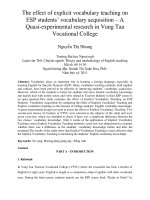The Effect of Auditory Call Playback on Anuran Detection and Capt
Bạn đang xem bản rút gọn của tài liệu. Xem và tải ngay bản đầy đủ của tài liệu tại đây (3.11 MB, 61 trang )
Marshall University
Marshall Digital Scholar
Theses, Dissertations and Capstones
1-1-2012
The Effect of Auditory Call Playback on Anuran
Detection and Capture Rates
Derek Adam Bozzell
Follow this and additional works at: />Part of the Aquaculture and Fisheries Commons, and the Population Biology Commons
Recommended Citation
Bozzell, Derek Adam, "The Effect of Auditory Call Playback on Anuran Detection and Capture Rates" (2012). Theses, Dissertations and
Capstones. Paper 227.
This Thesis is brought to you for free and open access by Marshall Digital Scholar. It has been accepted for inclusion in Theses, Dissertations and
Capstones by an authorized administrator of Marshall Digital Scholar. For more information, please contact
The Effect of Auditory Call Playback on Anuran Detection and Capture Rates
A thesis submitted to
the Graduate College of
Marshall University
In partial fulfillment of
the requirements for the degree of
Master of Science
Biological Sciences
by
Derek Adam Bozzell
Thomas K. Pauley, Ph.D., Committee Chairperson
Frank Gilliam, Ph.D.
Michael Little, Ph.D.
Marshall University
May 2012
Key Words: Anuran, breeding calls, automated recording systems (ARS), protocol,
visual encounter survey (VES), call monitoring, auditory surveys
Copyright by
Derek Adam Bozzell
2012
(ii)
ii
ACKNOWLEDGEMENTS
I would first like to thank Dr. Thomas K. Pauley, who gave me the freedom to
pursue my own interests and project. The ability to develop my own ideas, conduct my
own research, overcome my own mistakes and difficulties, and pursue my own passions
made my experience at Marshall University one I have benefitted immensely from.
I would also like to thank my other committee members for their time and
expertise. While I generally operated on my own, both Dr. Gilliam and Dr. Little were
there whenever I had questions or ran into problems.
Several members of the Herpetology Lab were crucial to the completion of my
thesis. Specifically, Scott Jones was also extremely helpful in familiarizing me with the
area and assisting me in selecting study sites. Nathalie Aall served as a field assistant for
the first year of my research. With her help, I did not have to try to both survey and
record data. Ben Koester was integral in helping me determine what statistical analyses
were appropriate for my data, and in helping format my data correctly. Also, even
though I ended up not needing to use many of his suggestions due to changes in the
project, Nathan Shepard was excellent for brainstorming and always had some useful
statistical ideas.
I would especially like to thank Dr. Elmer Price. He provided funds to purchase
additional call monitors needed for my project. This, in addition to the $500 Summer
Thesis Award from the Graduate College completely funded my project.
iii
TABLE OF CONTENTS
ACKNOWLEDGEMENTS ............................................................................................... iii
TABLE OF CONTENTS ................................................................................................... iv
LIST OF TABLES .............................................................................................................. v
LIST OF FIGURES ........................................................................................................... vi
ABSTRACT..................................................................................................................... viii
INTRODUCTION .............................................................................................................. 1
Order Anura and Amphibian Declines ........................................................................... 1
Overview of Current Anuran Survey Methods ................................................................ 3
Project Rationale............................................................................................................. 4
Project Objective and Hypotheses .................................................................................. 6
METHODS ......................................................................................................................... 7
Study Sites ....................................................................................................................... 7
Field Seasons................................................................................................................. 12
Survey Methods ............................................................................................................. 12
Data Collection ............................................................................................................. 15
Data Analysis ................................................................................................................ 17
RESULTS ......................................................................................................................... 18
Survey Efficiency Analysis ............................................................................................ 18
Detection Rate Data Analysis ....................................................................................... 19
Capture Rate Data Analysis .......................................................................................... 20
DISCUSSION ................................................................................................................... 20
Interpretation of Results ................................................................................................ 20
Issues with This Study ................................................................................................... 23
Future Work .................................................................................................................. 24
APPENDIX ....................................................................................................................... 25
LITERATURE CITED ..................................................................................................... 41
CURRICULUM VITAE ................................................................................................... 45
iv
LIST OF TABLES
Table 1: Location information of study sites.
Table 2: Site boundary types and the transect style used to survey each site.
Table 3: The Beaufort Wind Code scale used in NAAMP protocol to note categorical
wind speed during survey.
Table 4: The Sky Code scale used in NAAMP protocol to note sky cover and weather
during survey.
Table 5: The Massachusetts Noise Index, used by NAAMP to measure ambient noise
categorically.
Table 6: The Calling Index used by NAAMP to provide a categorical abundance
measurement of calling individuals during survey
Table 7: Results of the detection rate data analysis.
Table 8: Results of the capture rate data analysis.
v
LIST OF FIGURES
Figure 1: A map of the study areas of this project, Beech Fork State Park and Green
Bottom Wildlife Management Area.
Figure 2: A map of the study site locations in Beech Fork State Park.
Figure 3: A map of the study site locations in Green Bottom Wildlife Management Area.
Figure 4: A Google Earth aerial photo of Beech Fork State Park, contain labeled points
for BFSP1-BFSP8.
Figure 5: A Google Earth aerial photo of site BFSP1.
Figure 6: A Google Earth aerial photo of site BFSP2.
Figure 7: A Google Earth aerial photo of site BFSP3.
Figure 8: A Google Earth aerial photo of site BFSP4.
Figure 9: A Google Earth aerial photo of site BFSP5.
Figure 10: A Google Earth aerial photo of site BFSP6.
Figure 11: A Google Earth aerial photo of site BFSP7.
Figure 12: A Google Earth aerial photo of site BFSP8.
Figure 13: A Google Earth aerial photo of Green Bottom Wildlife Management Area,
contain labeled points for GRNB1-GRNB6.
Figure 14: A Google Earth aerial photo of site GRNB1,
Figure 15: A Google Earth aerial photo of site GRNB2.
Figure 16: A Google Earth aerial photo of site GRNB3.
Figure 17: A Google Earth aerial photo of site GRNB4.
Figure 18: A Google Earth aerial photo of site GRNB5.
Figure 19: A Google Earth aerial photo of site GRNB6.
vi
Figure 20: A diagram of the two types of transects used in this experiment.
Figure 21: A Song Meter SM2™ automated digital recording device, designed by
Wildlife Acoustics, attached to a tree.
Figure 22: The “callbox” used to play breeding calls during experimental surveys.
vii
ABSTRACT
The Effect of Auditory Call Playback on Anuran Detection and Capture Rates
Derek A. Bozzell
Calls of male anurans during breeding seasons are species-specific identification
tools. However, males cease calling after any nearby disturbance, including those of
researchers. I proposed a variation on current methods that attempts to reduce this lag in
calling after researcher-created disturbance by utilizing the propensity for competition in
male frogs. I surveyed 14 breeding sites in Cabell and Wayne counties during the 2010
and 2011 breeding seasons. First, I used traditional visual encounter surveys (VESs).
After using automated recording devices to gather site-specific recordings of calls of all
species present, I conducted secondary VESs while playing these playlists over a
loudspeaker. I expected this would increase anuran detection rates, capture rates, and
survey efficiency. Only Pseudacris c. crucifer showed a significant increase in detection
and capture rates when surveyed using callbacks, which is likely due to aggressive call
behavior. Survey efficiency comparison was dropped due to lack of calling activity.
Word count: 150
viii
INTRODUCTION
Order Anura and Amphibian Declines
Order Anura contains frogs and toads, which are collectively known as anurans.
Anurans are amphibians and, as such, most species deposit gelatinous eggs in water or
moist areas that hatch into aquatic larvae, whereas adults exhibit varying degrees of
terrestrial living, depending on the species (Pauley, 2011). Like most amphibians, many
anurans use cutaneous respiration; their skin is permeable and used in gas exchange, heat
regulation and osmotic regulation (Zug et al., 2001). Unlike other amphibians, most
anurans do not possess tails as adults; the word “Anura” is derived from the Latin prefix
an- (“not”) and the ancient Greek oura (“tail”) (Merrem, 1820). Anurans are also
especially adapted to saltatory movement, or jumping. Physiological adaptations for this
type of motility include a flexible vertebral column; reduced number and size of ribs; a
highly ossified appendicular skeleton; large, muscular hind limbs; and extended
metatarsals (Zug et al., 2001). One of the most striking adaptations of anurans, and the
one that this project relies on, is the auditory calls that males use to attract mates, and
defend territory from conspecific males, during the breeding season. The ability of
anurans to emit and detect these calls is highly derived and involves several adaptations
in the larynx, lungs, vocal sacs, and middle ear (Zug et al., 2001; Vorobyeva and
Smirnov, 1987).
Because of their unique skin, and the fact that they are exposed to both terrestrial
and aquatic environments during their lifecycle, amphibians are especially sensitive to
changes in the environment and to pollution. Amphibian species will be adversely
affected by negative impacts to their environment sooner than most organisms, and
1
because of this they are known as bioindicator species (Halliday, 2005a). In the late
1980s, it was discovered that amphibians have been experiencing drastic population
declines globally since at least the 1970s (Heyer and Murphy, 2005). Studies have since
shown that over one-third of all amphibian species are threatened, and over 120 species
are already likely extinct (Stuart et al., 2004). More recently, the extinction rate of
amphibians globally has been calculated to be 211 times the normal, background
extinction rate, and if all species currently considered threatened go extinct, that rate will
increase to 25,000 - 45,000 times greater (McCallum, 2007).
In 1990, several programs were dedicated to understanding and correcting the
underlying causes (Heyer and Murphy, 2005). Since these developments, there have
been considerable research and funding dedicated to this issue. Currently, there are
several different causes for amphibian decline being studied. Among the probable causes
are infection diseases, including Chytridiomycosis (Daszak et al., 1999); parasitic
infection (Sutherland, 2005); ultraviolet radiation (Blaustein et al., 1994); chemical
pollutants (Berrill et al., 1997; Bridges and Semlitsch, 2005); introduced species (Henle,
2005); habitat destruction, fragmentation and degradation (Green, 2005); increased
amounts of vehicular traffic (Henle, 2005); unsustainable harvest for the pet trade
(Wilson, 2005); and climate change (Reaser and Blaustein, 2005). Many researchers
believe a combination of these factors is leading to the continued population declines
observed in amphibians (Halliday, 2005b; Green 2005). Research to refine our
understanding of these issues, how they interact, and their effects on amphibians is still
underway.
2
Overview of Current Anuran Survey Methods
Traditionally, anuran breeding calls have been used to aid researchers in
estimating population parameters (Weir and Mossman, 2005; Weir et al., 2005). The
current anuran survey methods include intensive surveys, standardized (manual) call
surveys, and the use of automated digital recording devices (Corn et al., 2000). Under
ideal conditions in a simple system, as in a laboratory setting, these methods produce
similar species richness values (Corn et al., 2000). However, when used in the field, each
of these survey types has strengths and weaknesses.
Visual encounter surveys (VESs) are a type of intensive survey wherein the
researcher systematically searches the habitat of focus for a known amount of time
(Vonesh et al., 2010). This is a well-used and effective method for developing species
lists rapidly (Crump and Scott, 1994). Intensive surveys can also be used to gather
detailed population abundance or demographic information. However, as the name
implies, these methods require a great amount of time; researchers must be on the ground,
actively surveying sites in order to gather data. This is exacerbated by the fact that the
act of surveying creates disturbances that cause anurans to cease calling (pers. comm.
Thomas Pauley).
Standard, or manual, call surveys involve a researcher passively surveying a
breeding site by simply listening and recording the calling species. Controlled by the
U.S. Geological Survey (USGS), the North American Amphibian Monitoring Program
(NAAMP) is the most widespread manual call survey, and the largest anuran research
program, with 26 states in the eastern half of the country following the unified protocol
(Weir and Mossman, 2005). These surveys can gather data over a wide area, but in order
3
to do so logistically, the surveys must be volunteer-based, as seen in NAAMP. Even
though the data are checked by experts, using volunteers potentially reduces the accuracy
and credibility of the data. Also, the types of data collected are limited to
presence/absence data and categorical abundance numbers. One definite strength of the
NAAMP protocol is the standardization of environmental data collected.
Within the last 20 years, automated recording devices, or call monitors, have risen
in popularity in anuran surveying. These recording devices can be left in the field and set
to automatically record sounds, like the breeding calls of anurans, for a given period of
time at given intervals. Song Meter TM call monitors, a type of automated digital
recording device developed by Wildlife Acoustics, have become a common tool in
anuran surveys. Automated recording devices, such as the Song Meter SM2, are an
established method of monitoring breeding amphibians, especially for presence/absence
and basic abundance data (Corn et al., 2000; Acevedo and Villanueva-Rivera, 2006).
They are known to produce similar data to manual call surveys (Acevedo and VillanuevaRivera, 2006). In addition, they are also useful in capturing temporal variation in calling
behavior (Bridges and Dorcas, 2000). The main benefit of these devices is that they
require much less researcher effort to generate data similar to other methods (Penman et
al., 2005). Again, however, the types of data they can be used to generate are limited.
Project Rationale
With so much research remaining, and a decreasing completion window due to
the rapid declines and extinction rates of anurans, there is a need to maximize the amount
of data collected during anuran surveys. To meet this need, I have attempted to develop a
4
more efficient method of anuran survey than those currently available by combining
aspects of current survey methods in order to minimize the weaknesses of each. I have
proposed a new method of anuran survey that combines the detailed data gathered from
intensive surveys, the environmental data recorded from standardized surveys, and the
unique data collected from automated recording devices. In addition, I have incorporated
the idea of using auditory callbacks to lure males into calling. In order to understand the
reasoning behind including this aspect in my proposed method, one must first understand
how the traditional surveys interact when combined, and the calling behavior of anurans.
One of the historical difficulties with surveying anurans is that males cease calling
in response to any nearby disturbance, including those created by a surveying researcher
(pers. comm. Thomas Pauley). These periods of silence reduce the efficiency of
intensive surveys by forcing the researcher to remain inactive until the chorus beings
calling again. This reduction of efficiency is a negative impact on VESs, which generate
more detailed data than other methods, that other survey types do not encounter.
As mentioned, males use auditory calls to attract mates and ward off competing
males. These calls are species specific, and therefore useful identification tools (Weir
and Mossman, 2005; Weir et al., 2005). The pressure to attract a mate is so great that
males will often engage in call and response contests; when one male calls, a conspecific
will respond, in order to lose a potential mate. Hearing the call of a conspecific serves as
a stimulus to a male to begin calling (Jones and Brattstrom, 1962). In both laboratory and
field settings, it has been shown that males of several species are most likely to call in
response to the sound of a conspecific (Schwartz, 2001; Amezquita et al., 2005). It is
anecdotally assumed among researchers that using auditory callbacks entices male
5
anurans to call, in order to increase capture numbers (Gibbons, 1983). However, a
thorough literature search reveals no actual experiments designed to test this idea.
Automated recording devices provide a researcher with sound files of species
calls. My proposed method involves using these sound files to create site specific
playlists of calling species. I have created a portable, weather-resistant loudspeaker
system that can be used to play these calls while surveying. This project compares
survey results from traditional VESs with those of surveys with calls playing in the
background. The logic behind this approach is that the callbacks playing over the
loudspeaker system will entice the males at the site being surveyed to call in spite of
nearby researcher-created disturbances. This method would increase the amount of time
spent actively surveying, and increase the ability of a researcher to locate individuals
during VESs. Combining this with the standardized, detailed environmental data
recorded in NAAMP and the unique data gathered by call monitors could potentially
result in the most complete, data dense, and efficient anuran survey technique to date.
Project Objective and Hypotheses
The objective of this project is to determine whether the use of auditory callbacks
during surveys is preferable to traditional VES methods. To compare the effectiveness
of the methods, study sites were surveyed using both techniques and results, in terms of
survey efficiency, detectability, and capture probabilities, were compared.
The first hypothesis of this project is that the proposed method will increase
survey efficiency. The use of callbacks should lessen time required for males to begin
6
calling after a disturbance. If this is the case, time spent actively surveying during a
period of time will increase.
The second hypothesis of this project is that the proposed method will increase
detection rates of all species encountered when compared to traditional VES methods.
The use of callbacks while surveying may cause male anurans to ignore nearby
researcher-created disturbances. This increase in active survey time, combined with the
expected overall increase in calling behavior in response to the callbacks, will allow a
researcher to locate a higher number of individuals.
The third, and final, hypothesis of this project is that the proposed method will
increase capture rates for all species encountered when compared to traditional VESs. If
more time is available to actively survey, and more individuals are located during a
survey, more opportunities to capture individuals will exist. It should be feasible for a
researcher to capture more individuals per unit time.
METHODS
Study Sites
There were 14 study sites across two study areas, Beech Fork State Park in
Wayne County, WV, and Green Bottom Wildlife Management Area (WMA) in Cabell
County, WV (Figure 1). Sites consisted of a wide range of various habitats that serve as
breeding areas, including: wetlands, ponds, lakes, streams, flood plains, man-made water
bodies and vernal pools. A brief description of each study site, along with basic location
information can be found in Table 1. Sites were grouped into four sets, based on
achieving maximum distances between sites in each set, in an attempt to avoid pseudo
7
replication. If sites are in close proximity to one another, the calling behavior during a
survey at one site could influence the behavior of individuals at subsequent sites. This
could result in the inaccurate inclusion of species heard from a nearby site, not the site
currently being surveyed (Eigenbrod et al., 2008). There were two site sets at Beech Fork
State Park, each containing four sites, and two at Green Bottom WMA, each containing
three sites. Site set divisions can be seen in Figures 2 and 3.
Sites located in Beech Fork State Park were labeled ‘BFSP1 - BFSP8’ (Figure 4).
Site BFSP1 is a shallow alcove along the northern bank of Beech Fork Creek, roughly 65
meters southeast of a large pavilion named Shelter Number 4 (Figure 5). The site
consists of mostly denuded, muddy bottom, with a ring of grass hummocks around the
three sides that do not lead back to open water. In the spring, the water level is much
higher, and covers a large area of grass that is manicured by the park staff. The water
quickly recedes, however, and by July the area is mostly thick mud. There is still area to
survey, however.
Site BFSP2 is a small, shallow flood plain located along the northern bank Beech
Fork Creek that is very ephemeral (Figure 6). During the spring months, this site is
shallow and has a grass covered bottom. During both survey years, this site went dry
between May and June surveys.
Site BFSP3 is a moderately sized pond on the northern side of Beech Fork Road,
east of the intersection with Butler Adkins Branch (Figure 7). This is a permanent body
of water that contains fish. The site is characterized by tall grasses and thick vegetation
along the southern bank, and a relatively open northern bank.
8
Site BFSP4 is a small pool located on a small flat area on a roughly east-facing
slope (Figure 8). The pool is located immediately beside a power line right-of-way. It is
located in an open understory area, but there is some canopy cover caused by surrounding
hardwoods. This pool is vernal, and was dry before June surveys began.
Site BFSP5 is a large drainage field downhill from Beech Fork Road (Figure 9).
The site is located below the road roughly 100 meters southeast of the power line right of
way opening. The area is characterized by heavy canopy cover, but little understory.
The water is shallow, never exceeding a half meter in depth during surveys. This site is a
vernal water body, and during survey years it was dry by the time June surveys were
started.
Site BFSP6 is located in between Beech Fork Creek and the “Road to Nowhere”
(Figure 10). The area that floods is near the beginning of a nearby nature trail, just after a
bridge. This area has heavier vegetation than the other Beech Fork State Park sites.
There is a large amount of coverage by emergent vegetation, which mostly consists of
grasses and cattails. There are also several emergent trees. This site is vernal, and was
dry by June during both survey years.
Site BFSP7 is a small pond located behind the Blue Goose Picnic Area (Figure
11). It is in an area with an open understory, but a high amount of canopy cover. The
western and southern portions of the bank are level, but the northern and eastern portions
are steep, the eastern bank especially. The pond is spring fed. This pond is permanent,
and during the summer months, it is covered with a thick layer of duckweed.
Site BFSP8 is a flood plain of Beech Fork Lake at the beginning of the Lost Trail,
just after a bridge (Figure 12). The area is located just to the south of the first camping
9
area. This breeding location is vernal and characterized by very shallow water during the
spring. There is a high degree of emergent grass coverage. This site dried between May
and June surveys.
Sites located in Green Bottom Wildlife Management Area (WMA) were
designated as ‘GRNB 1-6’ (Figure 13). Site GRNB1 consists of the shallow area of
Hoeft Marsh near the first entrance along Route 2, when driving east. The area is
characterized by thickly vegetated banks, and an area of open water. As the water
became deeper, thick stands of buttonbush (Cephalantus occidentalis) prevented surveys.
This site contained the deepest water of all those surveyed. During the spring months of
2011, the water at this site was too deep to survey. During the summer months, the
water level was routinely around 80 cm in depth.
Site GRNB2 is located along the northern, treed boundary of the wetland across
the trail from Hoeft Marsh (Figure 14). Like other Green Bottom WMA sites, during the
spring months of 2011, the water level was too high to allow for survey by foot. During
the summer months, this site is overrun by American Lotus (Nelumbo lutea). This
drastically reduces possible survey area.
Site GRNB3 is an area of old field habitat located along the northern boundary of
the second wetland along the eastern side of the trail at the first entrance of Green Bottom
(Figure 15). The area serves as a floodplain for the wetland. It is characterized by a
mixture of open soil and emergent grass hummocks. While it also experiences high
water during the spring, this site is vernal and went dry between the June and July
surveys during both survey years.
10
Site GRNB4 is an alcove along the northern border of the large wetland
accessible from the second entrance to Green Bottom, when driving east on Route 2
(Figure 16). There is a boardwalk trail that follows the boundary of the wetland. This site
is roughly eight meters from that boardwalk. It is an area of open, muddy bottom,
surrounded by thick grass that reaches roughly one meter in height. It is open on the
south side, leading into the wetland with rapidly increasing depth. This site held water
during the entirety of both survey periods.
Site GRNB5 is a flooded field to the west of the second entrance of Green Bottom
(Figure 17). There is thick grass covering the entire area. This site had shallow water,
but the soil was so saturated that walking through the area was difficult. Every step
resulted in sinking to nearly the waist. However, this site is vernal and was dry during
the summer months of survey.
Site GRNB6 is an inlet at the north western corner of the large wetland accessible
from the third entrance of Green Bottom, if driving east along Route 2 (Figure 18). This
was the largest survey area, and it contained several different habitat types. There was
shallow water with a bare, muddy bottom as well as shallow water with a thickly
vegetated bottom. These shallow areas would lose water during the summer months, but
they quickly increased in depth. Deeper areas of this site were vegetated, with both
underwater and emergent, woody plants. This area contained several small islands; both
these and the surrounding banks were covered with thick vegetation.
11
Field Seasons
The local breeding season of anurans generally takes place from late February or
early March until late July or early August (Pauley, 2011). Field season start and end
points were based on observations of anuran calling activity. Due to delays in funding
and gathering materials, the first field season of the project was limited to June and July
of 2010. This served mostly as a trial run to determine sites and address any issues that
arose with the experimental design; however, data were collected.
The second field season occurred from March through July 2011. There were
several difficulties during the 2011 survey season that resulted in gaps in data collection.
The weather during the spring months, March through May, was extremely wet, resulting
in a great deal of flooding at Green Bottom WMA. Some sites were inaccessible, and
other sites were too deep to be surveyed by foot. Survey of the Green Bottom WMA
sites began in June. During May 2011, personal issues prevented the survey of site set 2.
During June of the 2011 season, vehicular issues prevented the survey of all Beech Fork
State Park sites.
Survey Methods
The project revolved around a cyclical field season. Each cycle consisted of
surveying a set of sites without the use of callbacks, recording calls, creating call playlists
for each site, and, finally, surveying with callbacks at that site set. Repeated surveys
were necessary to account for the fact that the breeding seasons of different species differ
temporally (Bridges and Dorcas, 2000). I was the only researcher to conduct surveys, in
12
an effort to minimize the effects observer bias and the effects of differences in observer
skill.
The first day at each site set consisted of surveying sites using traditional visual
encounter surveys (VESs). Because the sites surveyed represent a wide range of potential
anuran breeding habitats, specific methods were developed for different site types. Two
different transect styles were used for sites, depending on the characteristics of the water
body that served as the breeding site, but regardless of transect style, the area two meters
to either side of the transect line was surveyed. If the site had defined boundaries, such
as a pond, then a transect that circumnavigated the shallow area along the bank was used,
mainly due to limitations of my ability to survey deep water. If the breeding site was
shallow throughout, with no defined boundary, normal transects were used. The distance
between transects was decided based on overall habitat size. For sites designated
categorically as “small,” consisting of mainly small vernal pools and floodplains,
transects were five meters apart. For sites in the “medium” size class, such as larger
floodplains, transects were run 10 m apart. For the sites in the “large” size class, such as
the wetlands at Green Bottom WMA, transects were 15 m apart. This differentiation of
sizes and transect distances was done in an attempt to reduce survey bias in favor of more
transects in larger breeding areas. For all classes, transects were run along the shorter
axis of the water body. Table 2 contains a list of each site’s designated boundary type,
the transect type used and its size class. Figure 19 shows a diagram of survey transect
types. All surveys in this project were time-limited to 30 minutes or until the entire area
was surveyed. During surveys, if the chorus fell silent, I would turn off my headlamp
13
and wait quietly until the second individual began calling. I chose to wait until the
second calling individual in an attempt to counter especially aggressive or brave males.
On the second day, call monitors were placed at each site of the currently
surveyed site set and set to record for 10 min on every hour from 20:00 until 08:00 the
next morning (Figure 20). This regime was selected in order to capture calling activity of
all species in the study areas, as the point at which different species call throughout the
night vary (Bridges and Dorcas, 2000). A period of 10 min per recording was selected
because that time length represents the point at which diminishing returns in terms of
detection begin. The detection of calling individuals of 10 minute recordings does not
differ statistically from longer recordings (Pierce and Gutzwiller, 2004).
On the third day, completed recordings were collected and analyzed, i.e., I
listened to each recording in order to determine species composition at each site and then
used them to create playlists of site-specific calls. I made the decision to manually listen
to all recordings due to high inaccuracy and false positive rates found in the use of
automatic vocalization recognition software for anuran monitoring (Waddle et al., 2009).
These recordings were used to create site-specific playlists of calling species, which
would be played during secondary surveys. I altered recordings from the call monitors
using the sound editing software Audacity to create clear, one minute files containing
only the species of interest for use in the playlists. If it proved impossible to create a
clear file for a particular species using the recordings from the previous night, I used files
from The Frogs and Toads of North America CD by Lang Elliot et al. (2009) with any
speech edited out. These two days also act as a buffer between surveys of the site to
14
ensure that the collection/handling from the first survey has no impact on the males’
willingness to call during the second.
The fourth day consisted of repeating the surveys of the first day, but while using
the generated callbacks during surveying. In order to play calls while surveying, I built a
“callbox” using an MP3 player, an amplifier and a loudspeaker (Figure 21). I took a
plastic storage container and attached the electrical components to the interior using
Velcro strips. I drilled six holes into the side walls of the container and covered them
with plastic mesh to allow sound to clearly leave the container but prevent anything from
entering. The playlists generated from the call monitors would be loaded onto the MP3
player. The callbox also had a lid that sealed airtight in an effort to keep excess moisture
from harming the electronics. In the field, the callbox was placed at a random location in
the survey area. I returned to the randomly selected survey start point and allowed the
playlist to play twice while I waited quietly, in an effort to minimize the effect of my
placing the callbox elsewhere. I would then survey as normal. This four-day process
was repeated for each site set. The survey cycle repeated monthly, leaving 30 days
between the first surveys of the cycle at each site set.
Data Collection
The types and methods of data collection for this project are based heavily on the
North American Amphibian Monitoring Program (NAAMP) procedures (Weir and
Mossman, 2005). I began surveying approximately a half hour after true dark, following
NAAMP protocol. Site survey order was randomly decided prior to surveying.
15
Prior to surveying each site, I recorded weather information using a Kestrel 3500
Pocket Weather Meter. Using the Kestrel, I recorded current air temperature in degrees
Celsius (ºC), relative humidity (%), barometric pressure in millimeters mercury (mmHg),
water temperature in degrees Celsius (ºC), wind speed in miles per hour (mph), wind
direction, cloud cover, ambient noise, and percent vegetative cover. All of these
variables are known or suggested to affect anuran calling behavior (Granda et al., 2008;
Oseen and Wassersug, 2002; Schwartz, 2001). I also recorded wind speed using Beaufort
Wind Codes, a categorical measurement used by NAAMP, which is based on mph
measurements (Table 3). I recorded Sky Codes according to NAAMP protocol. Sky
codes assign numerical values to carrying weather types (Table 4). I recorded ambient
noise using the Massachusetts Noise Index, a categorical measurement of the effect of
auditory disturbance on surveying, also used by NAAMP (Table 5). As per NAAMP
procedures, Sky Codes 3 and 6 were not used (Weir and Mossman, 2005; Weir et al.
2005). Percent vegetative cover was measured using a square meter grid divided into 25
sections equal sections. Lastly, I recorded the NAAMP Calling Index of each species
heard at the site. The Calling Index is a measurement of the number of calling males at a
breeding site that ranks choruses into categories of 1, if calling individuals are easily
counted, 2, if individuals can be distinguished but not counted, and 3, if calls are
continuously overlapping (Table 6). This method is known to produce analogous results
to mark-recapture studies (Nelson and Graves, 2004).
During surveys, I recorded the species of any individual specifically located as
“Seen” and made an attempt to capture it by hand. If successfully captured, it was
recorded again as a “Captured” individual. If the anuran escaped, it was not marked as
16

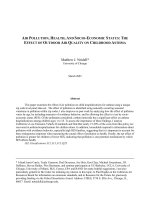
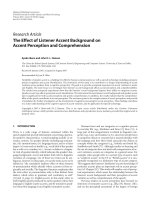

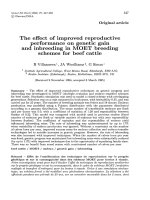
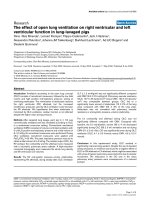

![ionescu - 2014 - the effect of mandatory partner rotation on audit quality [mapr]](https://media.store123doc.com/images/document/2015_01/06/medium_fam1420548198.jpg)
